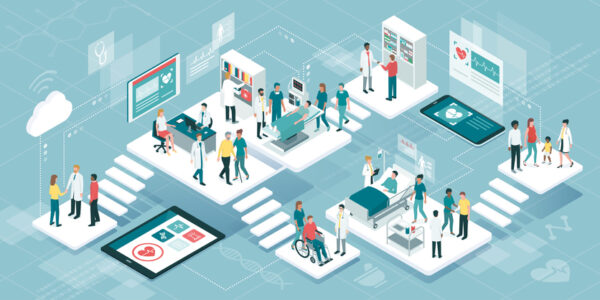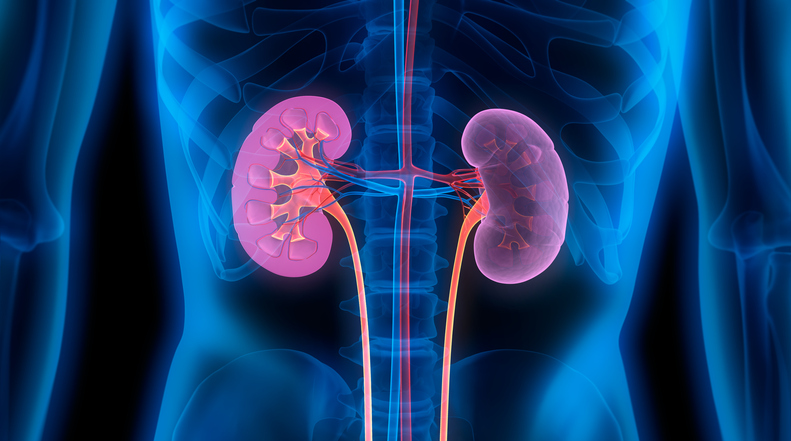
The hospital of tomorrow is already here today! Advances in data connectivity like the availability of 5G to maturing industry standards in low power communication technologies like BLE and Zigbee have resulted in the rise of an ecosystem that has made connections to people and machines ubiquitous and brought the world closer. This democratization of data has led to an explosion of technologies like wearables and other data rich user devices that have become common off-the-shelf commodities. Demographic trends point to a rapidly growing population, longer life spans and the rise of awareness of health needs that continues to rise exponentially. Advances in medicine and healthcare have reached new frontiers with new treatments like gene therapy and personalized management of diseases. These rely heavily on data as well as analytical tools that has led much of the charge in such progress. This rapid industrialization of the healthcare system increasingly needs a prescription for change. Digitalization and data analytics are a must to help meet the needs of this new connected hospital.
Industrialization of Healthcare: Strong drivers demand digitalization as a solution

The smart hospital will help:
- Streamline hospital workflow to meet current technology demands across the entire continuum of care
- Optimize information flow and business models to refocus professionals on their core business
- Use data effectively to bring connectivity between patients, professionals, equipment, and resources
- Integrate disparate data silos and help correlate layered information to provide actionable and timely advice when and where needed
- Help control costs by standardization, optimization and keeping track of non-conformance
- Spearhead advances in medicine by data driven research harnessing AI and ML capabilities
The use of data to continuously measure hospital performance is not new. Over the years, solutions to the growing need of measuring hospital KPI’s like patient outcomes, bed occupancy, efficacy of procedures and the like have become available. Information technology has largely provided the tools and solutions needed for these basic services past several years and continues to do so.

Health Benefit Consultants, Share Your Expert Insights in Our Survey
Share some of the trends you are seeing among your clients across healthcare, including chronic conditions, behavioral health, healthcare navigation, and more.
The smart hospital of today places a much bigger demand on these existing solutions which need to evolve and keep pace to meet current expectations. The explosion in the variety, velocity and volume of data, cloud-based virtualization strategies, easily scalable data storage solutions, rise in connectivity bandwidths and the commoditizing of handheld consumers of such information have resulted in making most solutions of the past years look obsolete almost overnight. The Industrialization of Healthcare has made new demands on digital applications and the need for harnessing technology enablers like artificial intelligence, secure clouds and edge computing.
Clearly the challenges posed by the Industrialization of Healthcare can only be solved by rapid digitalization along the entire continuum-of-care.
In the vision of such a Connected Smart Hospital is the concept of a digital twin. A virtual representation of the real hospital updated with real-time data that tracks the functioning of the hospital using data visualization and providing data driven decision-making using advanced analytics. Machine learning and artificial intelligence provide inputs where possible to augment human capabilities using prior data. Most engineering equipment of today possess data gathering possibilities that have already been put to good use for such monitoring. Diagnostic Imaging devices like MRI’s and CT scanners are fundamental to the efficient functioning of todays’ hospitals. Analyzing machine performance parameters and the operating health of these machines is key to ensuring their uninterrupted availability. The clinical engineering and facilities maintenance departments will welcome the availability of such continuous measurement. Bringing visibility into operational imperatives like heating, cooling, real-time location services of mobile equipment and the monitoring of uninterrupted power form a powerful incentive to integrate data for efficient running of the smart hospital.
Borrowing on concepts from the process industry and factory floor, the virtual digital twin of the connected hospital provides transparency into every stage of the patient experience. Secure cloud technologies and standards of inter-communication have made integrations with existing health systems possible though not exactly easy to achieve. Data flows along information pathways and standards when and where existing have enabled interoperability among disparate systems. By following a clean blueprint with a clear vision, a digital twin of the smart hospital can be realized using technologies available today.
Security of medical data is of paramount importance and the connected hospital will place an even bigger lens on these expectations. Requirements are stringent and current standards place a very heavy emphasis on the security of health-related data. Existing HIPAA standards and its need for administrative, physical, and technical safeguards need most information flows to be secure. Current ISO standards also prescribe a set of best practices for dealing with health data. Having a template and standard operating procedures for implementation of such systems will go a long way in meeting the levels of security required by the next generation of connected hospitals. A centralized security overview is often much better than a multitude of disconnected IT systems that offer possibilities of data leaks and breaches. Many large organizations have moved to secure data clouds which offer redundancy, fail proof fall backs, security levels, geographical boundaries, fault tolerances, hardening capabilities and other features that are just not available with older technologies. The smart Hospital will leverage these benefits and when well-designed can set new standards in the management of health data and its security.
In conclusion, we are at an exciting place and time and witnessing a paradigm shift in the rise of the connected hospital. Recent megatrends, including those accelerated by the Covid-19 pandemic have led to enormous strains on the healthcare Industry. On one front, this has necessitated the rapid Industrialization of the healthcare system leading to consolidation of hospitals, strain on supply-chain logistics, shortage of skilled manpower and the need for cutting cost while rapidly standardizing and optimizing quality of care. On a second front, technological advances have made data ubiquitous and raised expectations placed on hospitals and clinical services. The rise of wearable technologies, maturing of IoT standards, and availability of rapidly scalable and virtualized secure clouds will lead to continued advances of these concepts in the healthcare domain.
Puneet Pandit is the Co-founder, Chief Executive Officer of Glassbeam, and serves on its Board of Directors. He has over 25 years of global experience as a management consultant and as an operational executive building, scaling, and managing businesses with leading edge technologies ranging from Industrial IoT analytics in the healthcare market to data center-based storage networking vertical. Puneet co-founded Glassbeam with the core premise that machine logs will become the foundation for smart product companies to reinvent themselves in the world of connected machines and IoT analytics.














